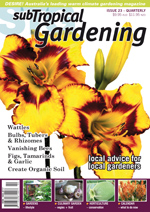Hovea acutifolia Family: Fabaceae A native to the southern forests of Queensland and nothern New South Wales, this open shrub to 3m is often seen in the bushland and domestic gardens. Though overlooked for most of the year, it comes into flower during the months of July, August and September. It is common to see this plant [...]
local advice for local gardeners
Sign up for our Community Email notices
Great Gardening Resources – sponsored links
subTropical Gardening magazine – Order Now
-
Recent Posts
Blogroll
- Index online
- Index PDF download
- Oz Garden Club forums
- STG back issues
- Subscribe to magazine
- USA Gardenology
- Subscribe in a reader
Get smart with the Thesis WordPress Theme from DIYthemes.
